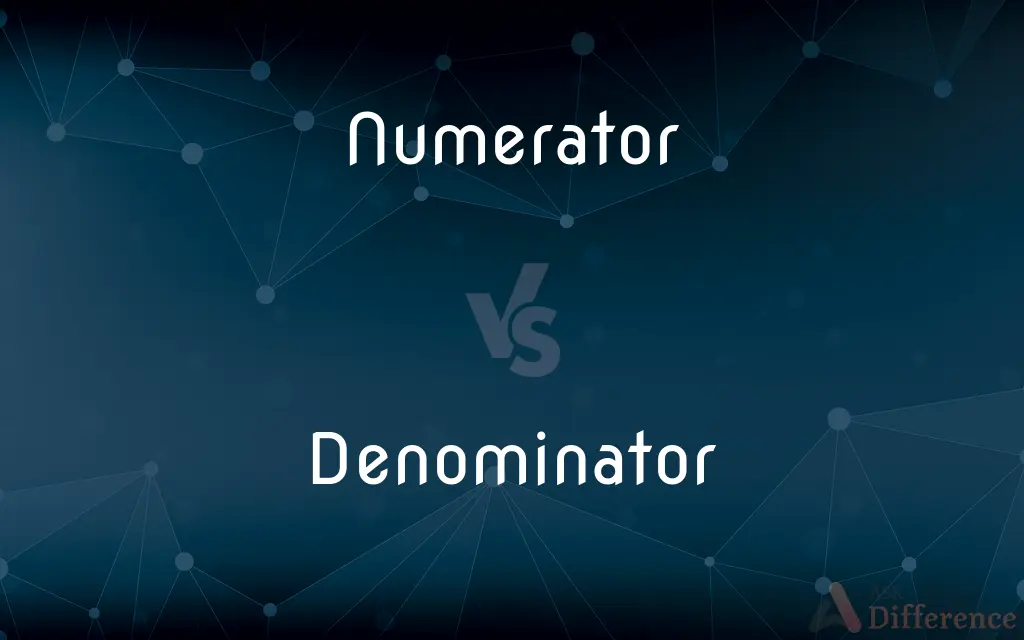Numerator vs. Denominator — What's the Difference?
By Tayyaba Rehman — Published on August 24, 2023
The numerator is the top part of a fraction, representing parts taken, while the denominator is the bottom part, indicating the whole.

Difference Between Numerator and Denominator
Table of Contents
ADVERTISEMENT
Key Differences
In the world of fractions, the numerator and denominator serve distinct roles. The numerator is the number on top of the fraction line, signifying the number of parts we're considering. On the other hand, the denominator, found below the fraction line, communicates the total number of parts that make up the whole.
Considering a real-life example, if you were to eat 3 slices of an 8-sliced pizza, the 3 slices you consumed would be the numerator. In contrast, the total slices, which is 8, represents the denominator. The fraction 3/8, in this case, indicates you've eaten 3 out of 8 slices.
When working with fractions, both the numerator and denominator are crucial for understanding the portion of a whole being described. If a fraction has a numerator greater than its denominator, like 7/5, it suggests the value is greater than one whole. Conversely, a smaller numerator compared to the denominator, such as 2/7, means the fraction represents a value less than one.
It's also worth noting that while both the numerator and denominator help define a fraction, they affect calculations differently. Multiplying or dividing both the numerator and denominator by the same number won't change the fraction's value. However, changing only the numerator or only the denominator will adjust the fraction's overall value.
Comparison Chart
Position
Top part of a fraction.
Bottom part of a fraction.
ADVERTISEMENT
Representation
Represents parts taken or considered.
Represents the total parts that make up the whole.
Value Influence
A larger numerator makes the fraction value bigger, while a smaller one makes it smaller.
A larger denominator makes the fraction value smaller, and a smaller one makes it bigger.
Relativity
Numerator can be any value from 0 to infinity, including values greater than the denominator.
Denominator cannot be zero in traditional mathematics.
In Fraction >1
If greater than the denominator, the fraction is greater than 1.
If smaller than the numerator, the fraction is greater than 1.
Compare with Definitions
Numerator
The expression written above the line in a common fraction to indicate the number of parts of the whole.
Denominator
Denominator indicates the total number of equal parts in the whole.
If a pie is sliced into 8 pieces, 8 is the denominator.
Numerator
Numerator is the number above the line in a common fraction.
In the fraction 5/6, 5 is the numerator.
Denominator
Denominator is the number below the line in a common fraction.
In the fraction 7/9, 9 is the denominator.
Numerator
Numerator represents the number of parts being considered.
If you have 3 out of 10 apples, 3 is your numerator.
Denominator
Denominator cannot be zero in traditional mathematics as it renders the fraction undefined.
5/0 is not a valid fraction because the denominator is zero.
Numerator
Numerator is the component of a fraction that can vary to represent different parts of the whole.
In the series 1/8, 2/8, 3/8... the numerator increases by 1.
Denominator
Denominator determines the kind or size of the fraction's parts.
In the fraction 3/12, the denominator tells us the whole is divided into 12 parts.
Numerator
Numerator is the value that signifies how many times the fraction goes into one whole.
A fraction with the numerator of 1, like 1/4, means you have one part of four.
Denominator
A fraction's value approaches zero as the denominator gets larger, assuming the numerator remains fixed.
As the denominator in 5/100, 5/1000, 5/10000 increases, the fraction's value decreases.
Numerator
An expression to be divided by another; a dividend.
Denominator
(arithmetic) The number or expression written below the line in a fraction (such as 2 in ½).
Numerator
Numerator can be greater than, less than, or equal to the denominator.
In 7/7, the numerator and denominator are equal, representing a whole.
Denominator
That number placed below the line in common fractions which shows into how many parts the integer or unit is divided.
Numerator
The dividend of a fraction
Denominator
(Mathematics) The expression written below the line in a common fraction that indicates the number of parts into which one whole is divided.
Numerator
One that numbers; an enumerator.
Denominator
A common trait or characteristic.
Numerator
(arithmetic) The number or expression written above the line in a fraction (such as 1 in ½).
Denominator
A determining factor or standard
"The tie is probably the single most important denominator of social status for a man in the United States today" (John Molloy).
Numerator
An enumerator; someone who counts.
Denominator
One who gives a name to something.
Numerator
One who numbers.
Denominator
One who, or that which, gives a name; origin or source of a name.
This opinion that Aram . . . was the father and denomination of the Syrians in general.
Numerator
The term in a fraction which indicates the number of fractional units that are taken.
Denominator
That part of any expression under a fractional form which is situated below the horizontal line signifying division.
Denominator
The divisor of a fraction
Common Curiosities
What is a numerator?
It's the top part of a fraction, representing parts taken or considered.
Can the numerator be greater than the denominator?
Yes, in such cases the fraction represents a value greater than one.
What happens if the denominator is zero?
In traditional mathematics, a fraction with a zero denominator is considered undefined.
Where is the denominator located in a fraction?
It's the bottom part, indicating the total parts of the whole.
Is it possible for both the numerator and denominator to be the same?
Yes, in such cases the fraction represents one whole.
Which number in the fraction 4/5 is the numerator?
4 is the numerator.
How does changing the numerator affect the fraction's value?
Changing the numerator will adjust the fraction's overall value relative to the whole.
How does a larger denominator influence the fraction's value?
A larger denominator, with a fixed numerator, reduces the fraction's value.
In which scenarios would the numerator be zero?
When none of the parts of the whole are being considered, the numerator is zero.
Does the denominator always represent the total?
Yes, it indicates the total number of parts that constitute the whole.
Share Your Discovery

Previous Comparison
Change vs. Alter
Next Comparison
Topic vs. SubjectAuthor Spotlight
Written by
Tayyaba RehmanTayyaba Rehman is a distinguished writer, currently serving as a primary contributor to askdifference.com. As a researcher in semantics and etymology, Tayyaba's passion for the complexity of languages and their distinctions has found a perfect home on the platform. Tayyaba delves into the intricacies of language, distinguishing between commonly confused words and phrases, thereby providing clarity for readers worldwide.
















































